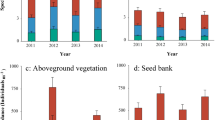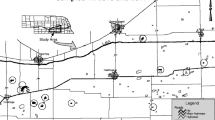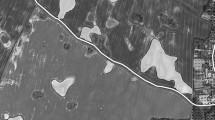Abstract
Proper management techniques on moist-soil wetlands provide methods for enhancement of established wetlands, restoration of former wetlands, and creation of new wetland habitat. These techniques also create suitable wetland habitat for non-breeding waterfowl and other wetland dependent species during winter. To understand moist-soil managed wetland vegetative patterns, aspects such as plant species distribution, reproductive strategy, seed bank composition and viability should be thoroughly characterized. We investigated soil seed bank potential of moist-soil managed wetlands on Richland Creek Wildlife Management Area, Texas to determine which treatment (i.e., drawdown or flooded) produced the most desirable moist-soil plants. A total of 27 species germinated, producing 3,731 and 3,031 seedlings in drawdown and flooded treatments, respectively. There were also differences in stem densities between treatments of desirable and non-desirable species. Drawdown treatments had more seedlings germinate than flooded treatments, validating the notion that drawdown treatments provide favorable conditions for seed germination. Drawdown and flooding techniques, when properly timed, will allow managers to drive and directly influence managed wetland plant communities based on seed bank composition and response to presence or absence of water during the germination period.

Similar content being viewed by others
References
Anderson JT, Smith LM (2000) Invertebrate response to moist-soil management of playa wetlands. Ecol Appl 10:550–558
Araki S, Washitani I (2000) Seed dormancy/germination traits of seven Persicaria species and their implication in soil seed-bank strategy. Ecol Res 15:33–46
Baldwin AH, McKee KL, Mendelssohn IA (1996) The influence of vegetation, salinity, and inundation of seed banks of oligohaline coastal marshes. Am J Bot 83:470–479
Baldwin AH, Egnotovich MS, Clarke E (2001) Hydrological change and vegetation of tidal freshwater marshes: field, greenhouse, and seed-bank experiments. Wetlands 21:519–531
Boedeltje G, ter Heerdt GNJ, Bakker JP (2002) Applying the seedling-emergence method under waterlogged conditions to detect the seed bank of aquatic plants in submerged sediments. Aquat Bot 72:121–128
Bossuyt B, Honnay O (2008) Can the seed bank be used for ecological restoration? An overview of seed bank characteristics in European communities. J Veg Sci 19:875–884
Bowyer MW, Stafford JD, Yetter AP, Hine CS, Horath MM, Havera SP (2005) Moist-soil plant seed production for waterfowl at Chautauqua National Wildlife Refuge, Illinois. Am Midl Nat 154:331–341
Budelsky RA, Galatowitsch SM (1999) Effects of moisture, temperature, and time on seed germination of five wetland Carices: implications for restoration. Restor Ecol 7:86–97
Capon SJ (2007) Effects of flooding on seedling emergence from the soil seed bank of a large desert floodplain. Wetlands 27:904–914
Capon SJ, Brock MA (2006) Flooding, soil seed bank dynamics and vegetation reliance of a hydrologically variable desert floodplain. Freshw Biol 51:206–223
Casanova MT, Brock MA (2000) How do depth, duration and frequency of flooding influence the establishment of wetland plant communities? Plant Ecol 147:237–250
Collins DP (2012) Moist-soil managed wetlands and their associated vegetative, aquatic invertebrate, and waterfowl communities in east-central Texas. PhD Dissertation, Stephen F. Austin State University, Nacogdoches
Correll DS, Johnston MC (1979) Manual of the vascular plants of Texas. University of Texas at Dallas Press, Richardson
Flynn KM, Mendelssohn IA, Wilsey BJ (1999) The effects of water level management on the soils and vegetation of two coastal Louisiana marshes. Wetl Ecol Manag 7:193–218
Fredrickson LH, Taylor TS (1982) Management of seasonally flooded impoundments for wildlife. United States Fish and Wildlife Service, Resource Publication 148
Galinato ML, van der Valk AG (1986) Seed germination traits of annuals and emergents recruited during drawdowns in the Delta Marsh, Manitoba, Canada. Aquat Bot 26:86–102
Gray MJ, Kaminski RM, Weerakkody G (1999) Predicting seed yield of moist-soil plants. J Wildl Manag 63:1261–1268
Gurnell AM, Boitsidis AJ, Thompson K, Clifford NJ (2006) Seed bank, seed dispersal and vegetation cover: colonization along a newly created river channel. J Veg Sci 17:665–674
Haukos DA, Smith LM (1993) Moist-soil management of playa lakes for migrating and wintering ducks. Wildl Soc Bull 21:288–298
Haukos DA, Smith LM (1997) Common flora of playa lakes. Texas Tech University Press, Lubbock
Haukos DA, Smith LM (2001) Temporal emergence patterns of seedlings from playa wetlands. Wetlands 21:274–280
Hopfensperger KN, Engelhardt KAM, Lookingbill TR (2009) Vegetation and seed bank dynamics in a tidal freshwater marsh. J Veg Sci 20:767–778
Howard RJ, Mendelssohn IA (1995) Effect of increased water depth on growth of a common perennial freshwater-intermediate marsh species in coastal Louisiana. Wetlands 15:82–89
Kadlec JA, Smith LM (1984) Marsh plant establishment on newly flooded salt flats. Wildl Soc Bull 12:388–394
Keddy P (1999) Wetland restoration: the potential for assembly rules in the service of conservation. Wetlands 19:716–732
Keddy P (2000) Wetland ecology principles and conservation. Cambridge University Press, Cambridge
Krebs CJ (1999) Ecological methodology, 2nd edn. Benjamin/Cummings, Menlo Park
Lane JJ, Jensen KC (1999) Moist-soil impoundments for wetland wildlife. US Army Corps of Engineers. Technical Report EL-99-11
Laubhan MK, Fredrickson LH (1992) Estimating seed production of common plants in seasonally flooded wetlands. J Wildl Manag 56:329–337
Leck MA (2003) Seed-bank and vegetative development in a created tidal freshwater wetland on the Delaware River, Trenton, New Jersey, USA. Wetlands 23:310–343
Leck MA, Graveline KJ (1979) The seed bank of a freshwater tidal marsh. Am J Bot 66:1006–1015
Leck MA, Simpson RL (1987) Seed bank of a freshwater tidal wetland: turnover and relationship to vegetation change. Am J Bot 74:360–370
Leck MA, Simpson RL (1993) Seeds and seedlings of the Hamilton Marshes, a Delaware River tidal freshwater wetland. Proc Acad Nat Sci Phila 144:267–281
Li EH, Liu GH, Li W, Yuan LY, Li SC (2008) The seed-bank of a lakeshore wetland in Lake Honghu: implications for restoration. Plant Ecol 195:69–76
McFarland DG, Shafer DJ (2011) Protocol considerations for aquatic plant seed bank assessment. J Aquat Plant Manag 49:9–19
McKee KL, Mendelssohn IA (1989) Response of freshwater marsh plant community to increased salinity and increased water level. Aquat Bot 34:301–316
Middleton BA (2003) Soil seed banks and the potential restoration of forested wetlands after farming. J Appl Ecol 40:1025–1034
Moore DRJ, Keedy PA (1988) Effects of water-depth gradient on the germination of lakeshore plants. Can J Bot 66:548–552
Natural Resource Conservation Service (2002) Soil survey of Freestone County, Texas. United States Department of Agriculture
Nicol JM, Ganf GG, Pelton GA (2003) Seed banks of a southern Australian wetland: the influence of water regime on the final floristic composition. Plant Ecol 168:191–205
Pederson RL (1983) Abundance, distribution, and diversity of buried seed populations in the Delta Marsh, Manitoba, Canada. PhD Dissertation, Iowa State University, Ames
Pederson RL, Smith LM (1988) Implications of wetland seed bank research: a review of Great Britain and prairie marsh studies. In: Wilcox DA (ed) Interdisciplinary approach to freshwater wetland research. Michigan State University Press, East Lansing
Sherfy MH, Kirkpatrick RL (1999) Additional regression equations for predicting seed yield of moist-soil plants. Wetlands 19:709–714
Shipley B, Parent M (1991) Germination responses of 64 wetland species in relation to seed size, minimum time to reproduction and seedling relative growth rate. Funct Ecol 5:111–118
Shipley B, Keddy PA, Moore DRJ, Lemky K (1989) Regeneration and establishment strategies of emergent macrophytes. J Ecol 77:1093–1110
Smith LM, Kadlec JA (1983) Seed banks and their role during drawdown of a North American marsh. J Appl Ecol 20:673–684
Smith LM, Pederson RL, Kaminski RM (eds) (1989) Habitat management for migrating and wintering waterfowl in North America. Texas Tech University Press, Lubbock, 560 pp
Strader RW, Stinson PH (2005) Moist-soil management guidelines for the U.S. Fish and Wildlife Service Southeast Region
Stutzenbaker CD (1999) Aquatic and wetland plants of the Western Gulf Coast. Texas Parks and Wildlife Press, Austin
ter Heerdt GNJ, Verweij GL, Bekker RM, Bakker JP (1996) An improved method for seed-bank analysis: seedling emergence after removing the soil by sieving. Funct Ecol 10:144–151
Texas Parks and Wildlife Department (2005) Texas comprehensive wildlife conservation strategy. Texas Parks and Wildlife Department, Austin
USDA, NRCS (2011) The PLANTS database. National Plant Data Team, Greensboro. http://plants.usda.gov. Accessed 23 June 2011
van der Valk AG (1981) Succession in wetlands: a Gleasonian approach. Ecology 62:688–696
van der Valk AG, Davis CB (1978) The role of seed banks in the vegetation dynamics of prairie glacial marshes. Ecology 59:322–335
van der Valk AG, Pederson RL, Davis CB (1992) Restoration and creation of freshwater wetlands using seed banks. Wetl Ecol Manag 1:191–197
Welling CH, Pederson RL, van der Valk AG (1988) Recruitment from the seed bank and the development of zonation of emergent vegetation during a drawdown in a prairie wetland. J Ecol 76:483–484
Acknowledgments
Financial and logistical support for this research was provided by the Texas Parks and Wildlife Department and the Arthur Temple College of Forestry and Agriculture (MacIntire-Stennis) at Stephen F. Austin State University. We thank Eric Woolverton, Edwin Bowman, Gary Rhodes, Kevin Kraai, and Matt Symmank for field and logistical support. We appreciate comments by C. Comer, B. Oswald, D. Scognamillo, G. Esslinger, and B. Howe on earlier drafts of this manuscript.
Author information
Authors and Affiliations
Corresponding author
Rights and permissions
About this article
Cite this article
Collins, D.P., Conway, W.C., Mason, C.D. et al. Seed bank potential of moist-soil managed wetlands in east-central Texas. Wetlands Ecol Manage 21, 353–366 (2013). https://doi.org/10.1007/s11273-013-9307-5
Received:
Accepted:
Published:
Issue Date:
DOI: https://doi.org/10.1007/s11273-013-9307-5




